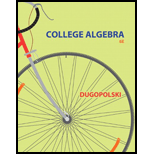
LINKING
concepts...
For Individual or Group Explorations
Modeling the U.S. Population
 To effectively plan for the future one must attempt to predict the future. Government agencies use data about the past to construct a model and predict the future. The following table gives the population of the United States in millions every 10 years since 1900 (Census Bureau, www.census.gov).
To effectively plan for the future one must attempt to predict the future. Government agencies use data about the past to construct a model and predict the future. The following table gives the population of the United States in millions every 10 years since 1900 (Census Bureau, www.census.gov).

a) Draw a bar graph of the data in the accompanying table. Use a computer graphics program if one is available.
b) Enter the data into your calculator and use exponential regression to find an exponential model of the form y = a • bx, where x = 0 corresponds to 1900.
c) Make a table (like the given table) that shows the predicted population according to the exponential model rather than the actual population.
d) Plot the points from part (c) on your bar graph and sketch an exponential curve through the points.
e) Use the given population data with linear regression to find a linear model of the form y = ax + b and graph the line on your bar graph.
f) Predict the population in the year 2020 using the exponential model and the linear model.
g) Judging from your exponential curve and the line on your bar graph, in which prediction do you have the most confidence?
h) Use only the fact that the population grew from 76 million at time t = 0 (the year 1900) to 309 million at time t = 110 (the year 2010) to find a formula of the form P(t) = P0 • ert for the population at any time t. Do not use regression.
i) Use the formula from part (h) to predict the population in the year 2020. Compare this prediction to the prediction that you found using exponential regression.
Want to see the full answer?
Check out a sample textbook solution
Chapter 4 Solutions
College Algebra Plus New Mymathlab With Pearson Etext Access Card
Additional Math Textbook Solutions
Mathematics for the Trades: A Guided Approach (11th Edition) (What's New in Trade Math)
Precalculus
College Algebra (Collegiate Math)
Elementary & Intermediate Algebra
Elementary Statistics: Picturing the World (7th Edition)
Precalculus: Mathematics for Calculus (Standalone Book)
- Solve questions by Course Name (Ordinary Differential Equations II 2)arrow_forwardplease Solve questions by Course Name( Ordinary Differential Equations II 2)arrow_forwardInThe Northern Lights are bright flashes of colored light between 50 and 200 miles above Earth. Suppose a flash occurs 150 miles above Earth. What is the measure of arc BD, the portion of Earth from which the flash is visible? (Earth’s radius is approximately 4000 miles.)arrow_forward
- e). n! (n - 1)!arrow_forwardSuppose you flip a fair two-sided coin four times and record the result. a). List the sample space of this experiment. That is, list all possible outcomes that could occur when flipping a fair two-sided coin four total times. Assume the two sides of the coin are Heads (H) and Tails (T).arrow_forwarde). n! (n - 1)!arrow_forward
- Evaluate the following expression and show your work to support your calculations. a). 6! b). 4! 3!0! 7! c). 5!2! d). 5!2! e). n! (n - 1)!arrow_forwardAmy and Samiha have a hat that contains two playing cards, one ace and one king. They are playing a game where they randomly pick a card out of the hat four times, with replacement. Amy thinks that the probability of getting exactly two aces in four picks is equal to the probability of not getting exactly two aces in four picks. Samiha disagrees. She thinks that the probability of not getting exactly two aces is greater. The sample space of possible outcomes is listed below. A represents an ace, and K represents a king. Who is correct?arrow_forwardConsider the exponential function f(x) = 12x. Complete the sentences about the key features of the graph. The domain is all real numbers. The range is y> 0. The equation of the asymptote is y = 0 The y-intercept is 1arrow_forward
 Glencoe Algebra 1, Student Edition, 9780079039897...AlgebraISBN:9780079039897Author:CarterPublisher:McGraw Hill
Glencoe Algebra 1, Student Edition, 9780079039897...AlgebraISBN:9780079039897Author:CarterPublisher:McGraw Hill Algebra: Structure And Method, Book 1AlgebraISBN:9780395977224Author:Richard G. Brown, Mary P. Dolciani, Robert H. Sorgenfrey, William L. ColePublisher:McDougal Littell
Algebra: Structure And Method, Book 1AlgebraISBN:9780395977224Author:Richard G. Brown, Mary P. Dolciani, Robert H. Sorgenfrey, William L. ColePublisher:McDougal Littell Holt Mcdougal Larson Pre-algebra: Student Edition...AlgebraISBN:9780547587776Author:HOLT MCDOUGALPublisher:HOLT MCDOUGAL
Holt Mcdougal Larson Pre-algebra: Student Edition...AlgebraISBN:9780547587776Author:HOLT MCDOUGALPublisher:HOLT MCDOUGAL Big Ideas Math A Bridge To Success Algebra 1: Stu...AlgebraISBN:9781680331141Author:HOUGHTON MIFFLIN HARCOURTPublisher:Houghton Mifflin Harcourt
Big Ideas Math A Bridge To Success Algebra 1: Stu...AlgebraISBN:9781680331141Author:HOUGHTON MIFFLIN HARCOURTPublisher:Houghton Mifflin Harcourt




